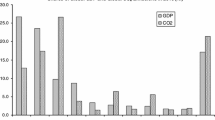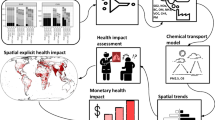Abstract
In this paper we focus on a long-term dynamic analysis of the optimal adaptation/mitigation mix in the presence of a pollution threshold above which adaptation is no longer efficient. We account for accumulation in abatement capital, greenhouse gases, and adaptation capital in order to better capture the arbitrage between abatement and adaptation investments. Pollution damages arise from the emissions due to the country consumption but also from the emissions of the rest of the world (ROW). A pollution threshold is then introduced, above which adaptation is no longer efficient. We obtain that if this threshold is lower than the steady-state level of pollution, there is no way for the modelled economy to avoid it. In particular, such a situation will appear if the ROW’s emissions are high. We then show that CDM may be a means to avoid a pollution threshold above which adaptation becomes of no use.








Similar content being viewed by others
Notes
Adding growth would prevent from analytically solving the model. Moreover, such an assumption together with the existence of a pollution threshold would lead to a degenerate solution.
There exists a difference between mitigation and abatement: the former refers to a reduction in net emissions of greenhouse gases while the latter refers to a reduction in gross emissions. In this paper, we integrate only emission abatement opportunities as it is largely the case in the literature. In the rest of the paper we will indifferently refer to mitigation or abatement.
Mitigation rather refers to a reduction in gross emissions, ie. mitigation efforts would lower \(\beta \) in Eq. (2).
Meridional Overturning Circulation.
It means that if doing no adaptation, home mitigation and international agreements are not enough to induce a pollution stock that is decreasing in time.
In the special case \(\alpha m=1\), which means that income Y has a linear impact on pollution accumulation, \(G^{\prime }(\theta ^{*})<0\) and \(F^{\prime }(\theta ^{*})<0\) that leads to a unique steady state and \(\phi ^{*\text { }}\)is constant. Moreover, it provides hints for the selection of the steady-state that should be considered for combinations of \(\alpha \) and m such that \(\alpha m\) is not too far from unity.
For clarity of the figure, we have chosen parameters such that \(F^{\prime }(\phi )>0\) but the same reasoning applies for a non-monotonous \(F(\phi )\) that could lead to more than 2 steady-states.
References
Agrawal S, Fankhauser S (2008) Economic aspects of adaptation to climate change: costs. Benefits and Policy Instruments, OECD, Paris
Amigues J-P, Moreaux M (2012) Potential irreversible catastrophic shifts of the assimilative capacity of the environment. IDEI Working Paper, No 697, 8 février 2012
Amigues J-P, Lafforgue G, Moreaux M (2014) Optimal timing of CCS policies with heterogeneous energy consumption sectors. Environ Resour Econ 57(3):345–366
Ayong le Kama A, Pommeret A, Prieur F (2014) Optimal emission policy under the risk of irreversible pollution. J Public Econ Theory 16(6):959–980
Benchekroun H, Marrouch W, Chaudhuri A-R (2011) Adaptation effectiveness and free-riding incentives in international environmental agreements. CentER Dicussion Paper 120, Tilburg University
Brechet T, Yatsenko Y (2013) Adaptation and mitigation in long-term climate policies. Environ Resour Econ 55:2
Buob S, Stephan G (2011) To mitigate or to adapt: how to combat with global climate change. Eur J Polit Econ 27:1–16
Buob S, Stephan G (2013) On the incentive compatibility of funding adaptation. Clim Change Econ 4(2):1–18
de Bruin KC, Dellink RB, Agrawala S (2009a) Economic aspects of adaptation to climate change: integrated assessment modelling of adaptation costs and benefits. OECD Environment Working Paper, No. 6
EEA (2007) Climate change and water adaptation issues. European Environment Agency, Technical Report No 2/2007
Gregory JM, Huybrechts P, Raper SCB (2004) Climatology-threatened loss of the Greenland ice-sheet. Nature 428(69–83):616–616
Hansen JE (2005) A slippery slope : how much global warming constitutes “dangerous anthropogenic interference”? Clim Change 68(3):269–279
Ikefuji M, Magnus J, Sakamoto H (2014) Adaptation for mitigation. Tinbergen Institute Discussion Paper 14-126/III
Ingham A, Ma J, Ulph A (2005) Can adaptation and mitigation be complements?, Tyndall Centre for Climate Change Research Working Paper 79
IPCC (2007) Climate change 2007, fourth assessment report of the intergovernmental panel on climate change. Cambridge University Press, Cambridge
Kane S, Shogren JF (2000) Linking adaptation and mitigation in climate change policy. Clim Change 45:75–102
Kane S, Yohe G (2000) Societal adaptation to climate variability and change: an introduction. Clim Change 45:1–4
Keller K, Yohe G, Schlesinger M (2008) Managing the risks of climate thresholds: uncertainties and information needs. Clim Change 91:5–10
Klein R, Huq S, Denton F, Downing T, Richels R, Robinson Toth F (2007) Interrelationships between adaptation and mitigation. In: Climate change 2007: climate change impacts, adaptation and vulnerability. The IPCC 4th assessment report. Cambridge University Press, Cambridge, pp 745–777
Link PM, Tol RSJ (2004) Possible economic impact of a slowdown of the thermohaline circultation: an application of Fund. Port Econ J 3:99
Naevdal E (2003) Optimal regulation of natural resources in the presence of irreversible threshold effects. Nat Resour Model 16(3):305–333
Parry M, Arnell N, McMichael T, Nicholls R, Martens P, Kovats S, Livermore M, Rosenzweig C, Iglesias A, Fischer G (2001) Millions at risk: defining critical climage change threats and targets. Global Environ Change 11:181–183
Prieur F (2009) The environmental Kuznets curve in a world of irreversibility. Econ Theory 40(1):57–90
Shalizi S, Lecocq F (2009) To mitigate or to adapt; is that the question? Observations on an appropriate response to the climate change challenge to development strategies. World Bank Res Observ 2:1–27
Smit B, Burton I, Klein JT, Wandel J (2000) An anatomy of adaptation to climate change and variability. Clim Change 45(1):223–251
Tsur Y, Withagen C (2013) Preparing for catastrophic climate change. J Econ 110(3):225–239
UNFCCC (2007) Climate change: impacts. Vulnerabilities and Adaptation in Developing Countries, United Nations Framework Convention on Climate Change
World Bank (2009) The costs to developing countries of adapting to climate change: new methods and estimates. The Global Report of the Economics of Adaptation to Climate Change Study, Consultation Draft
Yohe G, Strzepek K (2007) Adaptation and mitigation as complementarity tools for reducing the risks of climate impacts. Mitig Adapt Strateg Global Change 12:727–739
Zemel J (2015) Adaptation, mitigation and risk : an analytic approach. J Econ Dyn Control 51:133–147
Author information
Authors and Affiliations
Corresponding author
Additional information
We thank the seminar participants at LERNA University Toulouse 1, CIREQ University of Montreal, ArtDev University of Montpellier 1, 5th World Congress of Environmental and Resource Economists at Istanbul, bi-annual conference on Sustainable Resource Use and Economic Dynamics at Ascona.
Appendix
Appendix
The FOCs lead to
A steady-state is such that \(\overset{\cdot }{A}/A=0\) \(\overset{\cdot }{K}/K=0,\) \(\overset{\cdot }{S}/S=0,\overset{.}{c}/c=0,\) \(\overset{.}{\phi }/\phi =0\) and \(\overset{\cdot }{\theta }/\theta =0\). Equations (13), (14) and (6) gives:
Using the pollution accumulation process and the fact that at the steady-state \(\overset{.}{S}/S=0\), we have:
Rights and permissions
About this article
Cite this article
Ayong Le Kama, A., Pommeret, A. Supplementing Domestic Mitigation and Adaptation with Emissions Reduction Abroad to Face Climate Change. Environ Resource Econ 68, 875–891 (2017). https://doi.org/10.1007/s10640-016-0050-2
Accepted:
Published:
Issue Date:
DOI: https://doi.org/10.1007/s10640-016-0050-2




